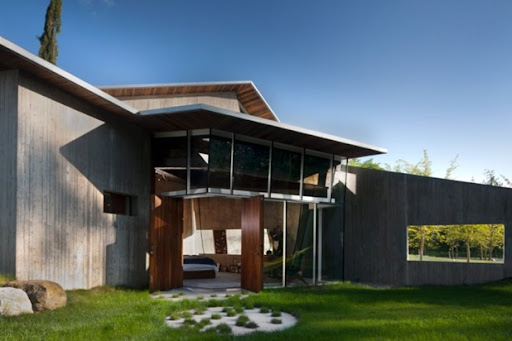
Omer arbel house series#
How did the inspiration for the 113 series come about?įor years I have been working on ideas resulting from the basic first step of matching the coefficient of expansion in glass and copper in terms of how one material transforms as a consequence of heat, and air flow, and affect the other. (Answers have been condensed and edited for clarity.) Yatzer recently caught up with Arbel to talk about his latest series and his multidisciplinary practice.

This technique not only creates uniquely shaped vessels with an unpredictable variation but also produces an iridescent finish on the outside as the hot metal doesn’t come into contact with oxygen, which makes for an uncanny contrast with the blackened texture of the oxidized interior. As each piece cools, the glass shatters off, leaving a metallic shadow of itself due to the calculated discrepancy in the coefficients when it comes to the expansion of the two materials. Part of an ongoing series of experiments exploring the relationship between copper alloys and glass, the 70 pieces on display at the Carwan’s industrial new space were made by pouring a liquid copper alloy inside glass vessels that have just been blown.

No less extraordinary is the process underpinning Arbel’s latest sculptural series, " 113", which is on display at the Carwan gallery in Athens – the venue’s first exhibition after it moved from Beirut to the Greek capital earlier this year. His accomplishments as an inventor include a technique of pouring concrete into a fabric formwork to explore the material’s plastic nature whether it be for buildings or sculptures, electroplating copper wires for thousands of times while submerged into an emulsified nickel solution to produce unique jewellery pieces, and reviving ancient Bohemian glassmaking formulas that utilize the bones of a rare breed of cattle. As opposed to most designers, he doesn’t dictate what the finished artefacts look like but rather allows the materials to prescribe their own form. What unites such diverse endeavours is his “alchemical” passion for experimenting with materials and inventing new manufacturing processes that take advantage of their intrinsic chemical, physical or mechanical properties.

From private residences, to sculptural vases, to suspended installations for institutions like the Victoria & Albert Museum and the Barbican Centre, to producing unique hand-crafted light fittings for Bocci, a design and manufacturing company Arbel founded in 2005, his multidisciplinary creativity knowns no limits. His conceptual approach, now fueled by an infrastructure for prototyping, fine craft, manufacturing and distribution, has given birth to a collection of conceptually driven lighting, furniture, electrical accessories and objects, which have since gained significant presence and impact within the design community.Vancouver-based artist, architect, designer and inventor, Omer Arbel, is if anything else a contemporary Renaissance man. In 2005, Arbel became Bocci’s creative director. Conversely, critics have noted that the practice’s built works appear to be inspired by an obsession with the object, the possibilities implicit in the process of making, and the intrinsic quality of materials. It has been said of Arbel’s practice that its industrial design works, in both limited edition and mass produced formats, appear to be motivated by larger scale concepts which can only be considered architectural. After apprenticeships at Miralles Tagliabue Architects and Patkau Architects, in 2005, Omer Arbel founded a multidisciplinary design studio focused on blurring the boundaries between the fields of building, industrial design, and materials research. The installation will remain at the museum until the end of 2013. The installation continued our research into the process of making, and stands testament to Arbel's remarkable journey as an articulator of form. 280 of the 28 pendants hung within a 30 metre vertical drop, suspended by a novel, perhaps awkward and heavy copper suspension system, that had as much presence or more than the glass it supports. On the other hand it was the most ambitious exploration to date of a novel glass blowing technique. The intent of the installation was twofold On the one hand, it was a pure celebration of the monumental open height of the building, which uses light to crystallize a powerful phenomenological experience for the viewer.

The installation, featuring the celebrated 28, descended through the large existing void cutting through the entire length of the V&A Building, with an astonishing height of more than 30 metres. We presented a massive, custom 28.280 chandelier in the main atrium of the museum. This is a time lapse video of our installation at The Victoria & Albert Museum atrium as part of the London Design Festival.


 0 kommentar(er)
0 kommentar(er)
